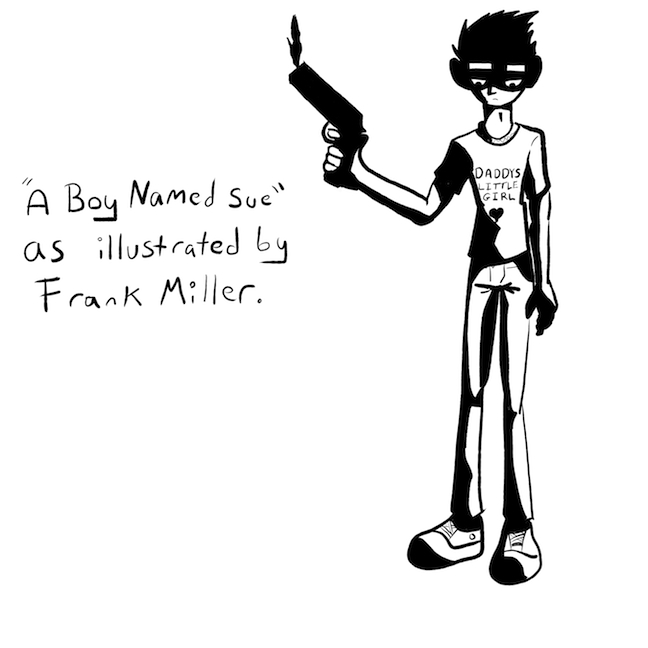
The song, more like spoken word than rock n' roll, tells the story of a young man named Sue who has had to deal with ridicule and shame his entire life. But what makes this seemingly goofy song so powerful? Even though he had memorized the basic chords, he didn't know the words and literally read them off a sheet of paper the first time he ever performed the song to a live audience at San Quentin.Īs you would hear from the shouts, laughs, and cheers, "A Boy Named Sue" was an instant hit: the synergy of Cash and Silverstein proved remarkable and the song soon climbed to number one on the charts. You see, Cash didn't even know "A Boy Named Sue" real well. Standing before a crowd of inmates, guitar in hand, Cash addressed the audience, asking one of his musicians for back-up help for his next song. The next year, he continued performing at other high-security establishments, including California's famous San Quentin Prison.

He had already skyrocketed to fame after the recording of his legendary At Folsom Prison album in 1968. That was the same year that Cash, having always harbored a soft spot for the down n' out, was in the middle of a concert tour of American prisons. June Carter, who had just married Johnny Cash, suggested that her husband try to play Shel's song and Cash agreed. Silverstein, famous for his wit and humor, debuted his newest song, the appropriately witty and humorous "A Boy Named Sue," during one of these guitar pools in 1969. All these talented guys used to get together and have "Guitar Pools," in which each person would go around the circle and introduce the group to his or her new song, and the other group members would critique them. Not to mention that he happened to be friends with Johnny Cash. In addition to penning a great deal of work for Playboy, Silverstein was a Renaissance man of sorts: along with being a poet and artist, he was also a prolific songwriter. (Your 4th-grade teacher probably didn't mention that.) Hugh Hefner sent Shel Silverstein all over the world so he could write an entertaining and satirical column on the most interesting people he could find from sea to shining sea. The guy was a regular contributing writer for Playboy during its first decade of existence, believe it or not. What you may not know about Shel Silverstein is that he also made quite a name for himself in the adult world.

Wait.Shel Silverstein? You probably remember him from the 4th grade, when you probably first read "A Light in the Attic," "Falling Up," or "Where the Sidewalk Ends." His poetry collections and trademark black and white sketches have captured the imaginations of people of all ages, making Silverstein a cultural icon for children's poetry. Eliot, Ezra Pound, and Gertrude Stein were all homies during the Modernist poetry movement Monet and Renoir sipped French coffee together at the peak of Impressionism and in the 1950s in America, Neil Simon, Elvis Presley, Bob Dylan, Kris Kristofferson, Shel Silverstein, Waylon Jennings, Willie Nelson, and Johnny Cash used to kick it every now and then.

Cash ( country music legend) (in 1956) publisher: Aberbach (London) ( Publisher), Carlin Music Corporation, Hill and Range Songs, Inc., Hill and Range Southwind Mus S A ( BMI-affiliated) and House of Cash, Inc.Isn't it interesting how great artists, writers, and musicians of every major movement somehow seem to end up becoming friends with each other? ( BMI-affiliated, publisher for works of Johnny Cash) recording of: I Walk the Line (on ) lyricist and composer: John R. Cash ( country music legend) (in 1956) publisher: Aberbach (London) ( Publisher), Carlin Music Corporation, Hill and Range Songs, Inc., Hill and Range Southwind Mus S A ( BMI-affiliated) and House of Cash, Inc. Recorded in: Memphis, Tennessee, United States (on ) producer: Bob Johnston ( American record producer) and Sam Phillips ( founder of Sun Records) acoustic guitar: Johnny Cash ( country music legend) (on, on ) double bass: Marshall Grant (on, on ) electric guitar: Luther Perkins (on, on ) vocals: Johnny Cash ( country music legend) (on, on ) phonographic copyright (℗) by: Sun Entertainment Corporation ( company credits only do not use as release label!) (in 1956) and Sun Record Company (in 1956) recorded at: Sun Studio in Memphis, Tennessee, United States (on ) part of: Rolling Stone Magazine’s 500 Greatest Songs of All Time ( as at ) (number: 30), Dave Marsh: The Best of the Top 40 Singles: 1956 (number: 33) and The Rolling Stone Magazine’s 500 Greatest Songs of All Time: 2021 edition (number: 76) recording of: I Walk the Line (on ) lyricist and composer: John R.


 0 kommentar(er)
0 kommentar(er)
